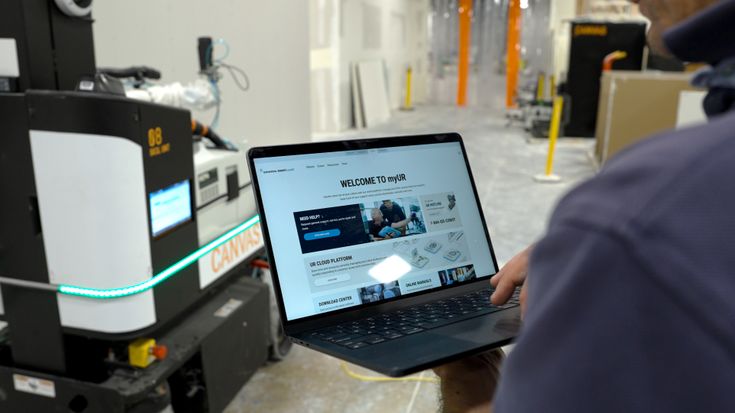Canvas
Drywall finishing robots accelerate construction schedules
In short
Construction sites, long considered bastions of manual labor, are experiencing a technological shake-up thanks to Canvas, a San Francisco startup that has developed a robotic system to tackle the arduous task of drywall finishing. By integrating UR10e cobots, Canvas has created a machine that dramatically reduces the time and effort involved in this traditionally labor-intensive trade.
The industry transformation
Kevin Albert, co-founder and CEO of Canvas, recognized the pressing need for automation in a dynamic industry facing a significant labor shortage. "We have to build twice as much over the next 40 years, but at the same time, we have two people retiring from the industry for every one that comes in," he explains. This urgency fueled Canvas' development of a mobile platform equipped with advanced sensing, AI, and UR cobots. Unlike the fixed environments of logistics and manufacturing, construction sites are inherently unique, making widespread robot adoption a challenge until now. “We've designed the system so that you don't need any prior plans; our machine automatically detects the site, so you can instantly bring the machine into the building and start working right away, no mapping required,” says Albert.
Canvas
Key value drivers:
Reduced schedules by up to 60% Reduced labor by approximately 40% Improved worker safety and ergonomics, addressing musculoskeletal problems
Tasks solved by collaborative robots:
Spraying and sanding joint compound on drywall
Automation challenges solved:
Automating in dynamic construction environments, where every site is unique Developing a lightweight yet strong mobile robot solution capable of reaching up to 15+ feet Achieving precise and gentle material handling of soft drywall compound
How they did it

60% reduction in schedules, 40% reduction in labor
The Canvas solution offers impressive results, slashing drywall finishing schedules by up to 60% and reducing labor requirements by approximately 40%. What once took five to seven days of manual spraying and sanding can now be accomplished in around two days for both Level 4 (drywall seams only) and Level 5 (entire wall) finishes. “In a manual approach, the worker has to keep coming back to the same wall, so 20,000 ft² of wall space takes about 100,000 ft² of work,” explains Albert. “With Canvas you only have to come back to that same wall three times.”

Worker safety and improved ergonomics – labor union approved
Beyond speed and efficiency, worker safety and ergonomics are significant drivers for Canvas' innovation. "One in every four construction workers ends their career with a musculoskeletal problem due to the repetitive and physically demanding nature of tasks like finishing and sanding,” says the Canvas CEO, emphasizing how the Canvas machine takes on the "brunt, hard work," freeing workers from these strenuous activities and potentially extending their careers. This collaborative approach, where robots handle the heavy lifting and workers focus on coordination and intricate areas, was a key reason for selecting the UR cobots. Canvas even successfully introduced this concept to labor unions by addressing their concerns about worker well-being, productivity, and upward mobility.

Unrivaled force control
At the heart of the Canvas system lies the Universal Robots UR10e cobot. “It is one of the lightest robots for the strength that it has,” says Albert, explaining how this was crucial for Canvas's mobile platform, enabling it to perform tasks up to 15 feet high without compromising stability. Maria Telleria, Canvas co-founder and CTO, highlights another critical aspect: UR's built-in force control. Given the delicate nature of drywall compound, which ‘you can actually scratch with your fingernail,’ precise and gentle application is essential. "We don’t need any external force control, it’s built into the robot arm and it’s extremely precise," says the Canvas CTO, mentioning how the company found the precision of the force control lacking in other cobot arms they evaluated.

Maturity of the UR platform
The maturity of the UR platform was a significant factor in Canvas's rapid development. "Only two months after receiving our first UR cobot, we were already undertaking our first job,” says Albert, crediting the "incredible" support from distributors and from UR. UR provides support through the myUR portal that streamlines support, while providing easy access to case submissions, logs, fixes, and comprehensive information on all Canvas’ UR arms. “We always get great responses through the portal, we file everything there and we can always find all info pertaining to all robot arms, every purchase, every warranty,” says Telleria, who also highlights the openness of the Universal Robot software platform, granting developers access to "all the low-level information" such as sensor data and the ability to customize control at the joint level. The availability of a DC version of the UR control box was also advantageous for Canvas's mobile platform, improving battery efficiency by eliminating the need for voltage conversion.

Aiming higher
Kevin Albert sees this as a pivotal moment; “Up until now, interior work has been entirely done by hand tools, this is the first time we have a heavy machinery platform for the interiors of construction spaces," he says. Looking to the future, Canvas aims to develop taller robots capable of reaching heights above 20 feet, further mitigating fall risks and enhancing worker safety. The company also see painting as a natural progression, leveraging their existing material spraying capabilities to offer even greater time savings and efficiency to construction projects.
Get in touch with Universal Robots
Thousands of businesses rely on Collaborative Robots to...
- Increase productivity
- Adapt to changing product demand
- Improve employee well-being and retention
- Staff through labor shortages
- Universal Robots USA, Inc
- 27175 Haggerty Road, Suite 160
- 48377 Novi, MI